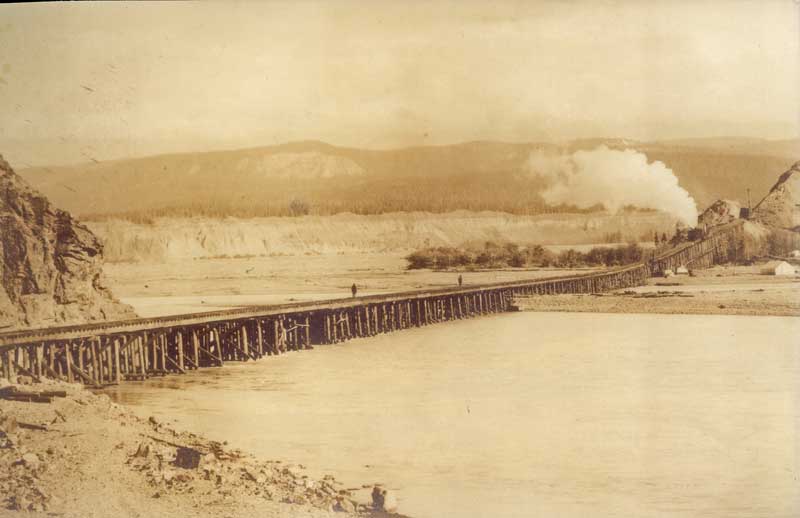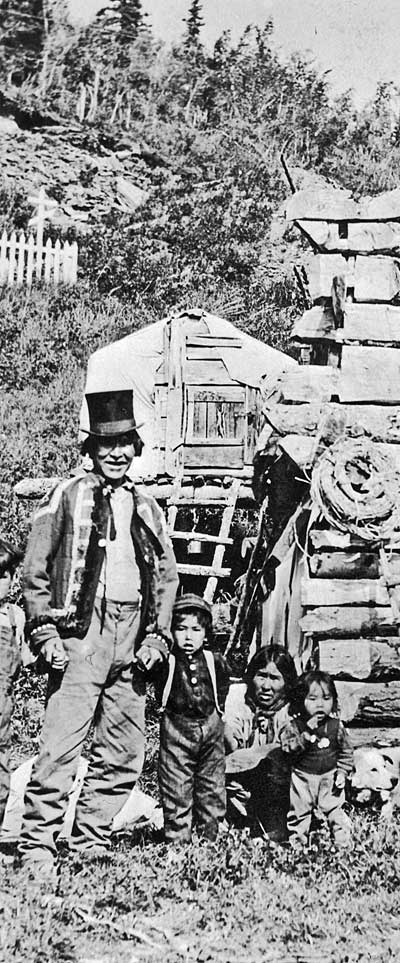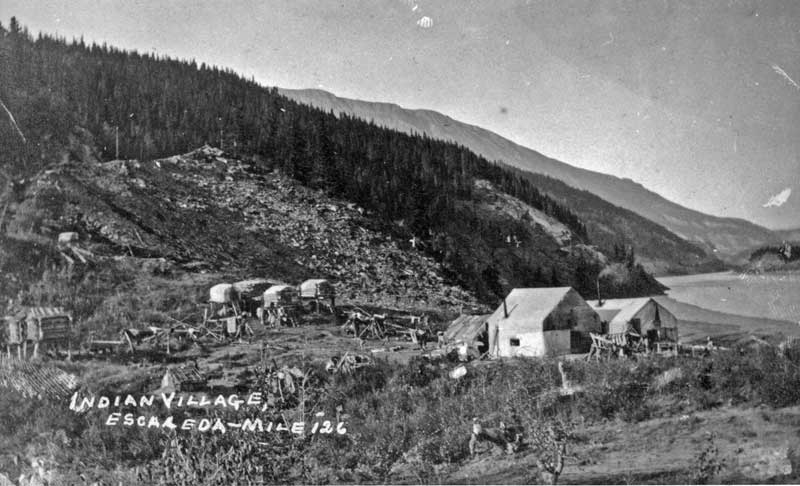Legacy of the Chief, Chapter 15: "Chitina Trestle Crossing" |
click on picture for larger image: some of these images appear in the book for this chapter. |
The Creator has long remained silent, but no more. He is warning us that we must remain as we are--humble, but prepared to protect the land of the Uk’eledi and our own people from the c’uniis of the white man. What lies ahead can no longer be predicted. All we know is that we are here now. What happens tomorrow now that the white man has arrived with his white devil spirits is not for us to know . . . It will be left to us alone to protect this land from the Yaabel which has followed the white man . . . --Nicolai talking to Eskilida, Skilly and Goodlataw at Taral in 1900. My grandfather, the great Chief Nicolai the Tyone, must have believed he would live on through his descendants. For those of us who knew him in those old days before he succumbed to the Spanish flu epidemic in 1918, he increasingly resembled a Biblical prophet of old. His being was such that he seemed greater than life. His words were powerful, though not always easily understood. Nor were his admonitions ones that many were prepared to follow. He demanded so much of himself all his life, and he relented little for the rest of us who mostly felt like mere children in his presence. He had a rare power to make us believe that we were a great people with a unique mission which we dare not fail. He was a masterful leader at a time when it looked like all of us as Ahtnas were doomed to extinction. We came close. The diseases alone almost completely wiped us out. He remained a solitary figure all his life. Yet he was the first one whom we sought when real trouble loomed. Although many of us are Christians now, at least in form, we are also Ahtna--the people of the Great River. We will always be Indians tied to the land, and we will forever carry with us the spirituality which the white man lacks. I have had much time to contemplate the words of my grandfather, whom we buried in the fall of 1918 in a secret place of his choosing along the north slopes of Spirit Mountain. Those of us who were there were sworn to secrecy. We believe that the power of the Great Sleep doctor lives on. It would be most unwise to disturb the spirit which resides at Taral. Nicolai was the last resident of Taral. No one would live there again. Nicolai’s problem with the Irishmen started in 1910. My problem started six years later, when I signed on with the railroad. F.A. Hansen, the CRNW superintendent had been right. The Irish crew was a particularly crude and obnoxious bunch of men who worked well as a team and wanted no other nationalities in their group. Foreman Patrick O’Malley did his best to keep the entire complement strictly Irish, but this time he was unsuccessful. Shortly after I signed on, Cap Goodlataw managed to pick up the other vacant position at Cascade in the fall of 1916, much to the obvious irritation of O’Malley and his band of ruffians. The Irish made clear from the beginning that they resented the intrusion of us Natives in their bastion. Cap and I made it equally obvious that we resented the Irish arrogance which made them think that they had a claim or a say to anything at all along Copper River Indian country. We Indians left no doubt that we did not really care one way or the other what the Irishmen thought. The situation at Cascade was always one of considerable tension, but the large work load kept the us too busy and too tired for any of us to bring the matter to a head for several months. Cascade was the station which maintained the long tunnel that tended to heavily ice up. We were constantly clearing it of the ice, because the trains were still on a daily schedule and had to be kept on line. Not only did the 300 feet of tunnel have to be kept operational, but the crew had to constantly check the tracks for defects several miles in both directions. Additionally, part of the crew was often pulled off to Tiekel or Bremner for other duties. Cap and I always volunteered for those assignments to escape the Irish antagonism. It was a busy winter. One night in late winter the Irish managed to sneak in some whiskey which they probably obtained through one of O’Malley’s connections at Chitina. The four Irishmen became hopelessly drunk by the time the two of us returned from a work assignment at Bremner on the hand car. Kay-yew-nee bared his teeth and growled when those men revealed their evil intentions. The whisky made them brave enough to think they’d run us out of Cascade by force. We were both sober, and quickly convinced them to back down, especially when our large dog started growling. Instead they began bragging about how great the Irish were and how much better they were than us siwash Indians. I held back Cap as long as I could. We might have endured the insults and animosity, but at some point O’Malley imprudently revealed that this crew of four Irishmen had all been on the ground-clearing crew near Eskilida’s camp when they came upon our Goodlataw family graves in August, 1910.
No one knows what the railroad really intended to do about the graves, but the spirit houses were standing right in the middle of the railroad survey lines. Some of us believe the railroad intended to relocate them, but they never had the chance before that Irish crew arrived. To the Irish, the graves stood out as a hated symbol of Indian pride. They must have truly despised us, because the Irish crew took it upon themselves to viciously rip the spirit houses apart and dig down into the graves, looking for valuable Indian relics while they thoroughly vandalized the site. I told this story to my sister Violet when Cap and I were at her small cabin playing poker with her and Uncle Tanas one night in 1917 while we were waiting to rebuild the bridge. “Sken’nie, I’ve heard about the desecration before, but it’s so hard to believe. How could anyone show so little respect for the dead?” “They thought they were above us, Saw-da, and were entitled to do anything they wanted to us, just as though they were slave masters. They never realized that the evil they were creating would one day return to them.” “It was at mile 127 where it happened, almost right across from Taral. Eskilida rushed to the graveyard when he heard the commotion only to be severely beaten by the four men. No one else was around to help. Grandfather did not find out about it until the next day.”
“He must have been enraged. Everyone knows how he gets.” “He must have been, Saw-da, but he deliberately kept us young ones out of it. The elders hid it from us as long as they could. Then they wouldn’t tell us who it was that did it.” “We did that because we wanted to protect you,” Tanas interjected. “I was one of the men who was summoned to help. It looked like Yaabel himself had been there to defile our dead. It was horrible. We were ready to kill any white man who came our way.” “The railroad must have told the men to lay low for a while, Tanas.” “No doubt about that, Johnny. Good thing, too.” Continue with "Chitina Trestle Crossing" (pt 2) |




No comments:
Post a Comment